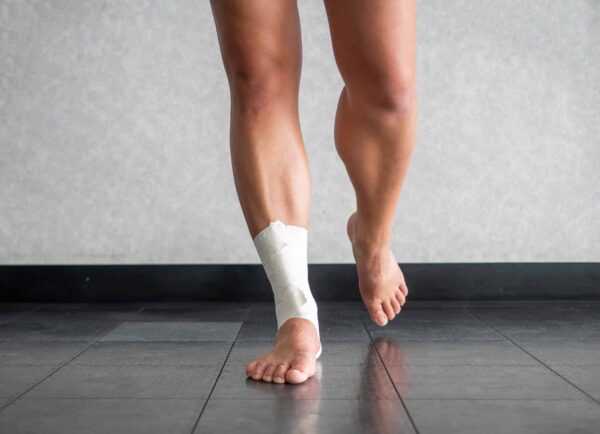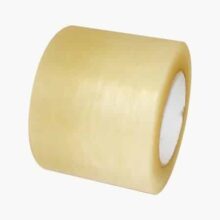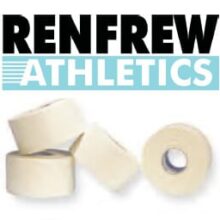Athletic Tape

Athletic tape falls into two primary categories – elastic and non elastic. Broadly speaking, it plays a similar role in supporting joints and soft tissues (ligaments, etc) as do orthopedic braces. However, again speaking generally, it is a lower profile solution than an orthopedic brace and is therefore easier to wear on the sports field. It does not interfere with joint range of motion to the same extent as would an orthopedic brace and also fits more easily under clothing, athletic or otherwise. This said, athletic tape requires some skill for its proper application, something that is not true of an orthopedic brace.
Types Of Athletic Tape
Non elastic adhesive athletic tapes usually come in cotton and/or polyester and have a zinc oxide adhesive mass backing. Due to their lack of elastic properties, they are less suited than elastic tapes for application to highly contoured parts of the body such as elbows and shoulders. The most common colour is white and the tape is usually available in widths of 0.5 , 1, 1.5 , 2 and 3 inches and in lengths of 10 to 15 yards.
Elastic adhesive athletic tapes (known as stretch tapes) come in 1,2,3 and 4 inch widths by 5 yard lengths. They are usually manufactured from twisted cotton with an adhesive backing. These tapes have the advantage of being able to conform to highly contoured areas of the body albeit providing somewhat less support than their non elastic counterparts.
What Determines The Quality Of An Athletic Tape?
The number of longitudinal and vertical fibres per inch in the backing of an athletic tape is an important factor in the assessment of its overall quality. Speaking generally, a high quality tape will have 85 or more longitudinal fibres and 65 or more vertical fibres per inch.
A high quality athletic tape will also possess a stronger adhesive backing with greater longevity. It will also display an even and fluid tension during removal from the roll.
Applications Of Athletic Tape
Athletic tape can provide important support to several areas of the body in order to counter different injuries:
Foot/Toe Taping
Arch taping can be used to provide support to the arch and forefoot areas. The foot & toes injuries that are treatable using adhesive tape include sprains, strains and overuse injuries.
The various taping techniques for the feet & toes include:
- Circular arch technique – used to provide mild support to the longitudinal arch of the foot. It is most commonly used for longitudinal arch strains as well as pes cavus and pes planus problems;
- “X” arch taping for mild to moderate longitudinal arch and forefoot support. This technique is useful for treating arch strains, plantar fasciitis and pes cavus and pes planus issues;
- Loop archtaping technique for mild to moderate support of the longituinal arch and forefoot;
- Weave arch taping for supporting the longitudinal arch and forefoot. This is perhaps the most supportive taping technique for the foot and toe region;
- Low-Dye athletic taping, which is commonly used for treating arch strains, plantar fasciitis and other lower leg injuries, for which it can provide moderate support and correct certain structural abnormalities. There is some research evidence that this taping technique can help to reduce the symptoms of some excessive pronation injuries such as tendinitis & stress syndronesies
Ankle Taping
Ankle taping can play a critical role in the treatment of several injuries to that part of the body, including ankle sprains and strains. It is also useful in the temporary immobilization of certain parts of the ankle immediately after a fracture or severe sprain.
Athletic tape can be useful in reducing the scope for ankle inversion and eversion at the subtalar joint. It can also be useful in reducing plantar flexion and dorsiflexion at the talocrural joint. By protecting against excessive joint range of motion, taping can help to reduce the risk of injury during competition or training. Athletes who have previously suffered ankle injuries can use taping to provide support to the ankle structures and promote more rapid and complete healing of injuries.
The ankle taping techniques that are in common use include:
- Closed basketweave taping to both prevent and treat ankle inversion or inversion strains. This technique provides moderate support to the subtalar and talocrural joints and helps to restrict range of motion of the ankle joint;
- “Heel locks” taping, which provides additional support to the subtalar and talocrural joints and helps to secure a closed basketweave tape job;
- Spartan slipper taping, which is used with the closed basketweave taping technique to treat inversion and eversion ankle sprains. It is also useful for providing additional ankle support while the patient is returning to sports activity or work;
- Subtalar sling taping, which, like the Spartan slipper, is used with the closed basketweave for additional subtalar joint support.
A popular application of athletic tape in the ankle area is the use of “spatting”. This technique is widespread in football and involves applying adhesive tape over athletic shoes. However, the support from spatting is generally not adequate for satisfactory prevention of ankle inversion, eversion or other sprains.
Lower Leg Taping
The lower leg injuries that are treatable by means of athletic tape include strains, ruptures and overuse injuries. Taping techniques that are normally used for this part of the body include:
- Achilles tendon taping to treat strains and achilles tendinitis by limiting excessive dorsiflexion and stretch on the tendon;
- Dorsal bridge taping to limit excessive plantar flexion and stretch on the achilles tendon when treating anterior tibialis tendinitis. This is also useful when treating ankle sprains and trying to restrict plantar flexion;
- Peroneal tendon taping to treat ankle sprains during the period when the patient is transitioning back to normal activity. The goal here is to limit excessive inversion and eversion at the subtalar joint. It also provides moderate support & stability to the peroneal tendon to facilitate its more rapid healing;
- Posterior splint taping to immobilize the foot/ankle during treatment of an achilles tendon rupture or peroneal tendon subluxation and/or dislocation. Use of this technique is most common in the acute treatment stages of these conditions.
Knee Taping
This is perhaps the area with the largest number of applications for athletic tape. Tape is applicable for the treatment of a wide variety of knee injuries including, but not necessarily limited to, knee sprains, meniscal tears, anterior knee pain, nerve contusion, knee bursitis and overuse injuries.
The various knee taping techniques in common use are:
- McConnell taping which is popular in the treatment of patellofemoral syndrome as well as relieving pain and correcting patellofemoral misalignment;
- Hyperextension taping, which helps to limit knee hyperextension and reduce stretching of soft tissues when treating knee sprains;
- Collateral “X” taping for the treatment of medial and lateral collateral knee ligament sprains by providing mild to moderate support against valgus and varus forces at the knee;
- Patellar tendon strap taping, which helps to treat patellar tendinitis, Osgood Schlatter Disease, patellofemoral syndrome and chondromalacia. It reduces the tension of the patellar tendon on the inferior pole of the patella as well as on the tibial tubercle.
Thigh, Hip & Pelvic Taping
As with many of the other body areas, athletic tape can be instrumental in the treatment of thigh, hip and pelvic strains and overuse injuries. The various taping applications for this part of the body are:
- Circular thigh taping to provide mild thigh support and to anchor protective padding material to the thigh. Therapists can use this technique with either off the shelf or custom made padding when an athlete is returning to activity. The padding will help to absorb shocks during collisions and prevent injuries such as quadriceps contusions;
- Hip pointer taping, which helps to absorb shocks that may result in hip contusions (bruises). It also anchors protective padding to the iliac crest.
Shoulder/Upper Arm Taping
Athletic tape also has many applications to the shoulder/upper arm area. The injuries in this part of the body that are treatable by taping include sprains, strains and overuse injuries. Taping techniques specific to this area include:
- Circular Upper Arm for mild upper arm support and for anchoring or protective padding;
- Shoulder pointer/AC joint sprain taping to anchor padding to the shoulder. This padding will help to absorb shocks to the shoulder that may then aggravate contusions and AC joint sprains.
Elbow Taping
Applications of athletic tape to the elbow and forearm can be done using the following techniques and for the following purposes:
- Hyperextension taping to help limit elbow hyperextension (straightening) and its accompanying stretch on the soft tissues of the joint;
- Lateral epicondylitis strap taping to help treat the symptoms of tennis elbow. This taping technique helps to reduce the tension of the wrist extensor muscles at their point of attachment to the bony prominence of the elbow;
- Circular forearm taping to provide mild support to forearm muscles and to anchor protective padding that absorbs shocks to that area and reduces the risk of contusions;
- Figure-of-eight elbow taping. Like circular forearm taping, this provides mild elbow support but also anchors protective padding to prevent and/or treat elbow contusions and olecranon bursitis.
Wrist Taping
Wrist injuries that are treatable by the application of athletic tape include contusions, sprains, fractures, dislocations and overuse injuries such as de Quervain’s syndrome and carpal tunnel syndrome. The taping techniques specific to the wrist include:
- Circular wrist technique to provide mild wrist support and limit joint range of motion. However, it also can anchor protective padding to the wrist to help prevent contusions, fractions and dislocations;
- Figure-of-eight wrist taping that provides mild to moderate wrist support, limit wrist range of motion and anchor protective padding;
- Fan, strip & “X” taping to provide moderate wrist support. These techniques also limit excessive wrist flexion and extension and is therefore useful when treating wrist sprains, fractures and dislocations.
Conclusion
Athletic tape has many uses all over the body for treatment of soft tissue repetitive stress or trauma injuries. It is also useful for supporting protective padding to help prevent contusions due to external shocks.
In addition to these roles, athletic tape also plays a critical role in restricting joint range of motion. It is used for this purpose in order to to help prevent or treat fractures or dislocations.






